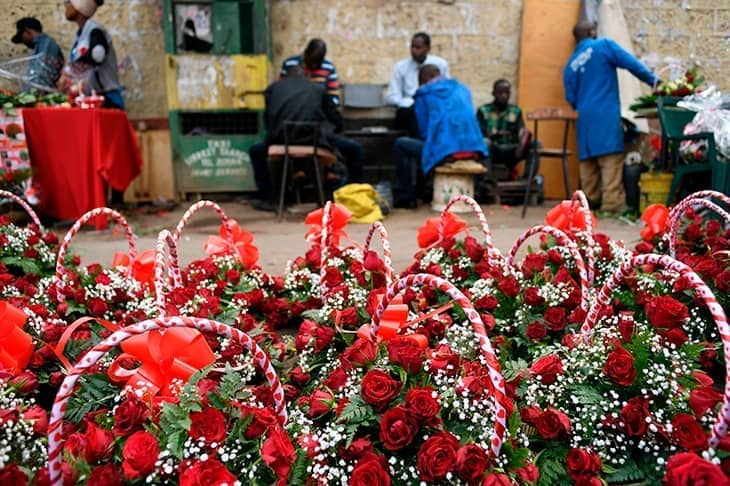The alpine slopes of Kenya’s extinct volcanoes are the floral equivalent of Bordeaux. It’s there that the roses grow for the world’s weddings, funerals and Valentine’s Day bouquets. The higher the altitude, the larger your flower head, and roses raised in the shadow of Mount Kenya’s glaciers, or on the vast caldera of Mount Elgon, come in a dazzling spectrum of colours, petal shapes and scents.
In normal years, billions of blooms fly out of Nairobi, destined for everywhere from Shanghai and Riyadh to Melbourne and Slough. But in 2020, the roses bloomed in vain.
The world’s skies emptied of aircraft in March 2020, and Kenya’s rose growers threw away mountains of flowers that could not be exported. Workers took armfuls of roses home — but job layoffs followed the collapse of business and many workers drifted home to villages and back to the soil. To lift the spirits of slum dwellers, Nairobi’s governor distributed bottles of Hennessy, which he described as an anti-virus throat sanitiser.

I worried that the industry wouldn’t recover, but in fact the speed with which it bounced back was astonishing. For the rest of the pandemic, rose growers like Tim Hobbs on Mount Kenya did a roaring trade. ‘Flowers became a proxy for seeing people — thinking of you, wish we were together,’ says Tim, who supplies the likes of Wild at Heart, Simon Lycett and the Real Flower Company. Next-day flower deliveries quadrupled. Bob Andersen, who grows 80 million roses a year on a Mount Elgon farm his family has had for a century, sent huge numbers of roses each week to Russia, some of them travelling nine days across Africa, then by plane to Holland, then by truck to Novosibirsk on Siberia’s mighty river Ob.
Flowers are peculiarly gratifying to give and to get: there’s the elation of being given them, seeing them open, thrive, fade and then die. Even throwing them away is satisfying.
In January 2020 we sent my Aunt Beryl flowers from Kenya for her 92nd birthday. In May that year, she died in a Sussex hospital alone with none of us allowed to visit her. Like many families, we haven’t been able to gather loved ones to say goodbye to her properly yet, and her ashes are still at the undertakers, but when we can, we’ll buy more flowers.
Kenya is gearing up for a global tsunami of funerals, memorials and weddings. Bob tells me that for two years his Charmant (the farm’s champagne-tinted rose variety, once wildly popular at European nuptials) found no buyers — but with the global riot of weddings planned for this year, the problem with roses will be the huge demand.
And as the world wakes from hibernation, the spectrum of different national tastes for roses is unfurling once more. Russians love a dark, almost black red rose and all good Russian schoolchildren take roses to their teachers in September. Europeans like a brighter red. Japanese like pink; the Arabs and Kazakhs go garish. In Norway they shun yellow, which symbolises jealousy. The Chinese like anything unusual, such as the spidery Hashtag, which Bob says has petals like Virginia Wade’s petticoats. The English will return to buying pastels and what Tim calls ‘nude palette’ colours — khakis, wild moss and dusty greys. The thing I value most is scent, because I miss it so much after entirely losing my sense of smell when I had the virus last year. Sadly, I’m told that roses with a lovely smell have more delicate petals, which kills them in transit, while growers admit that scent is sacrificed in favour of colour, opening shape, stem length, vase life and productivity.
Kenya is gearing up for a global tsunami of funerals, memorials and weddings
This Valentine’s Day and for the different international Mother’s Days that follow, the big challenge for Kenya’s horticulturalists is China’s hogging of the world’s airfreight and reefer container capacity to shift car chips and electronics. Freight bottle-necks and shocking inflation on things like fertilisers mean flower margins are leaf thin, but Bob says that even if there are hard economic times ahead, people will splurge money on roses. ‘It goes like this: “Sorry love, we can’t go on holiday this year, or buy the 70-inch-screen TV, and I’m not buying you a new car — but here’s a bunch of flowers.”’ As for 14 February — according to my rose-growing pal Pete Viljoen (whose family has been in Africa since his Huguenot ancestors arrived in 1672): ‘You’re still going to have to keep your wife happy with flowers since you’ve already bought flowers for your mistress.’
A longer-term challenge is the growing obsession with climate change. Younger generations may not yet be able to afford or wish to buy as many roses as older people like me, who don’t care and still don’t believe that there are 57 genders, but everything is apparently about to change. To grow a rose in Europe during the winter burns six times more carbon than raising it in tropical Kenya, where jobs help millions to avoid starvation; yet there are ever more complaints about flying roses around the globe. Eco-conscious millennials are the buyers of the future and so it makes sense to invest in new technologies which mean that you can refrigerate your roses in a cryogenic gel and ship them by sea. Bob tells me that henceforth all his roses will be selected for sea-freight tolerance and no more will be flown.
Pete spends much of his time talking about healthy soils that require fewer fertilisers and chemicals, and about creepy crawlies that provide natural solutions to pests. Tim holds forth about pig manure, earthworms and something called frass, which is the faeces and other gunk generated by black soldier fly maggots.
Around his farm Bob has built a hospital and several schools. He has funded 800 young Kenyans from local families to study at university. I have never once thought about the carbon it took to fly a rose to me, but these rose men are furiously planting forests and constructing fields of solar panels and hydropower, while building great reservoirs to capture water from rain running off their greenhouses so that they never need to extract from a river or a well. Bob, who is an aviator, says that roses will soon be flown around by hydrogen-power engines. Kenya’s flower sellers are nothing if not adaptable.







Comments